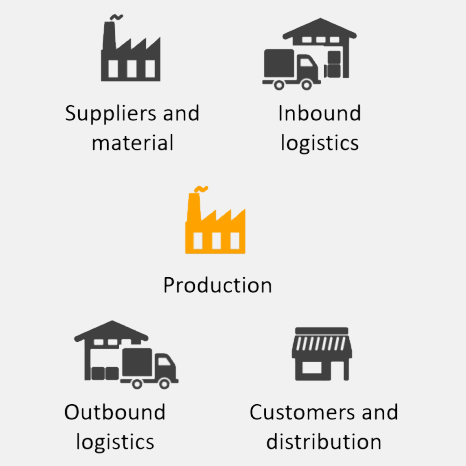Supply chain definition – what is a supply chain.
The term Supply chain can be defined as “the sequence of processes involved in the production and distribution of a commodity” and it is generally said to concern the management of 3 main flows:
- Material or product flow – includes all items related to the physical movement and storage of the incoming materials and outgoing products.
- Information flow – concerns the exchange of information, such as quotations, orders, delivery status, invoices and complaints between suppliers and customers.
- Financial flow – relates to the financial movements, the movement of money generally from a customer to a supplier.

The material flow and some of its logistics flows
The material flows from our supply chain definition can be divided into a certain number of logistics flows and are supported by various logistics delivery or movement methods. On this page you can find our definitions for some of these main logistics and supply chain materials flows:

This supply chain definition and the below logistics and supply chain flows definitions are part of our Introduction to Supply Chain material flows and terms training.
You can find this short course here – and use the coupon FLOW5 at check out to get it for $5 and enjoy its full audio and interactive learning features.
OUTBOUND
Outbound logistics relates to the storage, transportation, and distribution of goods to customers. It goes from the customer’s order receipt through to the delivery of the ordered product.
INBOUND
Inbound logistics concerns the flows incoming goods and their transportation and storage. It goes from the order placement to the receipt of the sourced item for transformation or consumption.
REVERSE LOGISTICS
Reverse logistics concerns the return shipments of goods or packaging and covers items such as the return of unsold products, defective goods, goods to be refurbished or repaired, reusable packaging, or disposal of waste.
DIRECT SHIPMENT
A transport of goods, from a supplier directly to its place of transformation, consumption or storage.
DISTRIBUTION CENTER
Distribution centers can be used domestically or internationally with larger shipments sent from various of your locations or suppliers to a regional distribution warehouse, which then dispatches smaller loads to regional customers. They can be used to store material for later distribution, but also as an instant cross-docking distribution system.
DROP SHIPMENT aka Third Party shipment, aka Direct delivery, aka Material Shipped Direct
Purchased material or products may be shipped directly from your supplier to your customer, without transiting through one of your locations. These direct deliveries could join and be consolidated en route with other direct supplier deliveries or deliveries from your plant or storage locations.
INTERCOMPANY or INTRACOMPANY
Intercompany or Intracompany relates to the flows of goods between two or more business units or locations of a same parent company or group of businesses and could concern anything from a delivery of goods from a plant to another for further transformation, a stock transfer between different locations, or a delivery to a company location for consolidation and customer delivery.
It is important to understand the difference between Intercompany and Intracompany as it notably dictates how to prepare certain shipping paperwork.
Intercompany refers to a move between locations of 2 different business entities, 2 different companies of a same group, a same corporation.
Whereas Intracompany refers to a shipment between 2 locations of a same single company, the same legal entity.
MILK RUN
Milk run gets its name from the milk truck which would tour local farms to collect milk for the processing plant. In place of having multiple suppliers sending small, or irregular larger shipments, a pre-scheduled truck leaves the main plant, picking up from multiple suppliers and consolidating the goods before returning to the plant. During this milk run, returning goods, or usable packaging material, may also be dropped off.
VENDOR TO VENDOR aka Supplier to Supplier
A Vendor to Vendor or Supplier to Supplier shipment relates to the movement of material from one of your suppliers to another for further transformation or consolidation.
WAREHOUSE CONSOLIDATION
Deliveries (typically short hauls ones) are made from a supplier to a warehouse, where they are consolidated with the deliveries of other suppliers before being shipped on.
And some more operational logistics terms:
FIRST MILE
First Mile is used to describe the movement of goods from the initial collection point to the first hub, the first consolidation place.
LAST MILE
Last Mile is used to describe the movement of goods from the last hub (a distribution center or other deconsolidation point) to the final destination.
LONG HAUL aka Line Haul
Longer distance transports are often called Line Haul or Long Haul.
BACKHAUL
The return trip of a truck (be it full or empty). Also used to describe any return load taken after a delivery.

These supply chain and logistics and supply chain flows definitions are part of our Introduction to Supply Chain material flows and terms training.
Use the coupon FLOW5 at check out to get it for $5 and enjoy its full audio and interactive learning features.
Subscribe to our newsletter for more notifications and discounts.


